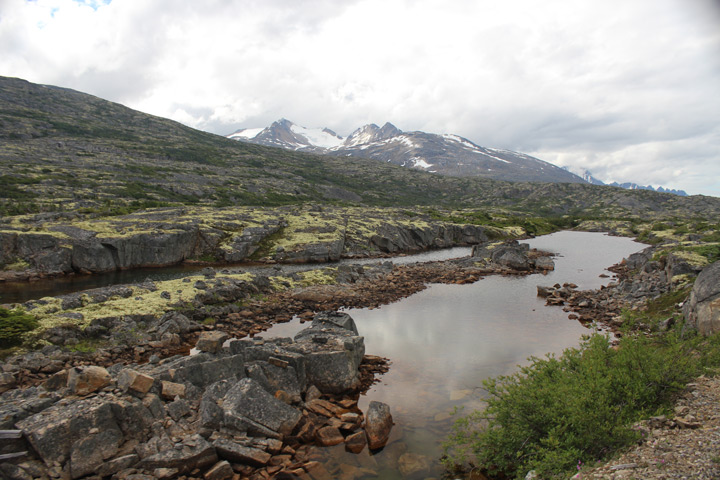Chris & Allyson vs. Alaska (2016)
Chapter Five: Skagway and Hubbard Glacier.
By 1896, gold-crazed maniacs were getting tired of Juneau. The easy pickings were gone, and the people making serious money off gold were the guys who owned the mining companies. Illiterate, violent and amoral white guys were watching their dreams of fabulous overnight wealth wither on the vine.
But their prayers were answered! Some guy found gold in the Klondike region of the Yukon, a remote and inhospitable part of Canada. Thousands of scuzzbuckets packed their bags, skipped out on their gambling debts and lurched north.
William Moore had anticipated all this. Moore, a steamship captain, was a veteran of several gold rushes in the Pacific Northwest, each time trying to rake in the cash. His travels took him through the Inside Passage in the 1880s. Upon noticing a good spot for a wharf about 90 miles north of Juneau, he rolled the dice. Moore acquired a bunch of land at a spot the Tlingit called "Skagua," built up some infrastructure, started cutting deals with the natives and waited for lightning to strike. When it did, Moore suddenly found himself in control of the gateway to the Yukon. For most people, it was a gateway to hell, but they still paid tolls to go through it. If the gold rush hadn't materialized, he'd be remembered as a lame land speculator. Instead, he's remembered as a visionary.
The Klondike Gold Rush lasted only four years, but it's like a butterfly tattoo on the back of the American spirit. It's not a mark of distinction, but it won't go away, and everyone wants to know the story behind it. Adventurers and authors left behind all kinds of legends, filled with brutal fights against nature and men on the dirty edge of society.
Skagway is the physical remains of that legend. The town is a sliver of its former self, with fewer than 1,000 year-round residents. These days, it survives only because of tourism. And the best way for tourists to get there is on a cruise ship.
Skagway was the fourth and final port for our cruise, and we were on the dock by 8 a.m. You have to be up bright and early, because in Skagway you are railroaded into doing the one "can't miss" attraction. It happens to be a railroad.
When prospectors arrived in Skagway in the late 1890s, that was only the start of their next horrible, horrible journey. The gold fields were inland, and the most popular way to get there was the Chilkoot Trail. That 33-mile road through the coastal mountains would be a bit dicey with modern hiking gear, in ideal weather conditions. Back then, it was far worse. Canadian authorities required travelers to haul enough supplies to survive for months on end, because the Canadians didn't feel like wasting their time or money searching for frozen corpses.
Moore and some business partners thought they could build a better road, along the canyon of the Skagway river and through the lower-elevation White Pass. But with all the rain in coastal Alaska, the route wound up being a mud pit for months at a time. Thousands of pack animals died on the trail, and since it cost money to remove them, people would just pitch the corpses into the canyon. It soon acquired the tasteful nickname "Dead Horse Trail."
The next season, someone tried to establish a tolled wagon road, but no one had invented EZPass yet. The human filth attracted to a gold rush weren’t all that interested in respecting the fees, so that venture died.
But there was still gold in them thar hills. So in 1898, some investors decided to go REALLY big. Acquiring the necessary rights of way (including the wagon road), they brought in engineering wizard Michael Heney to build them a railroad.
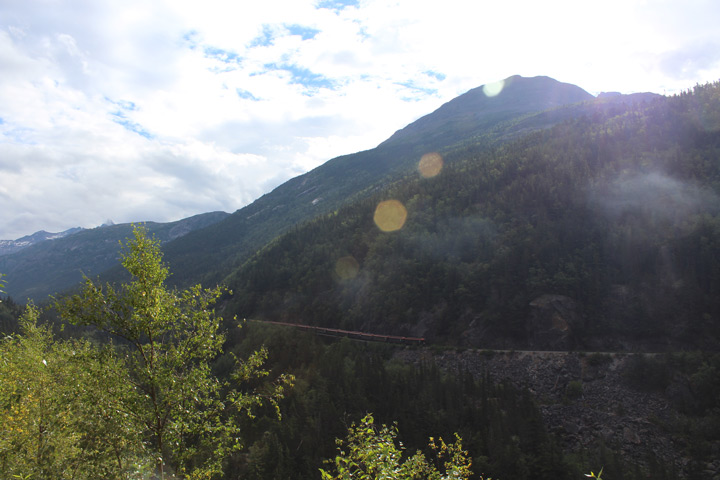
The White Pass & Yukon Railroad, seen from the modern highway that shadows it.
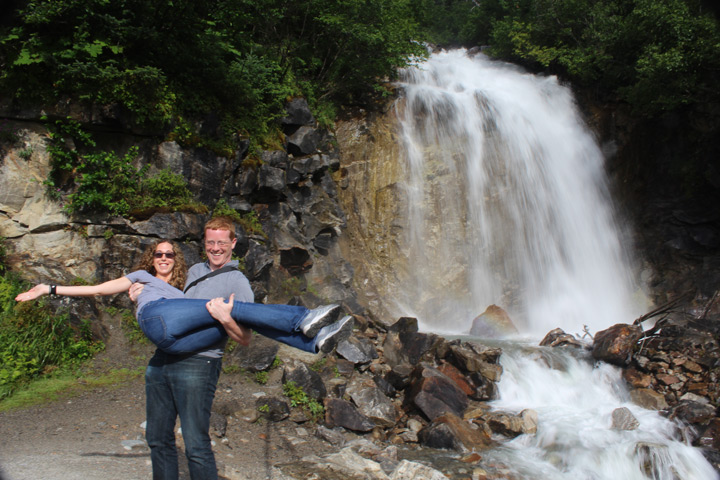
A roadside photo op on the road to Canada.
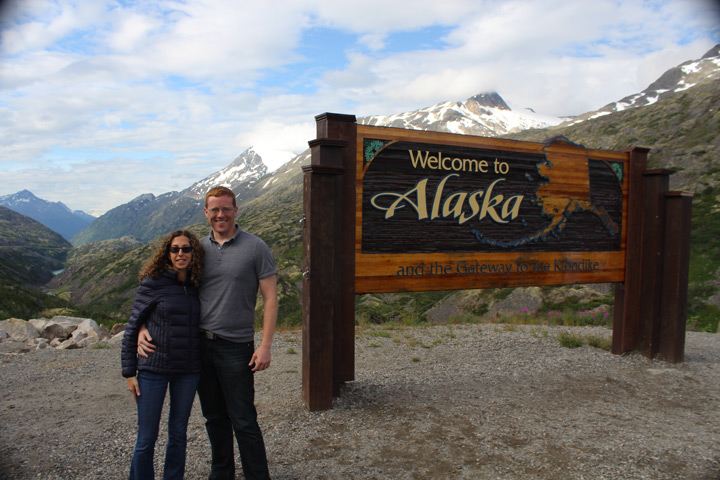
Crossing into Canada, stopping, then turning around for the picture.

Uh, Alaska is pretty.
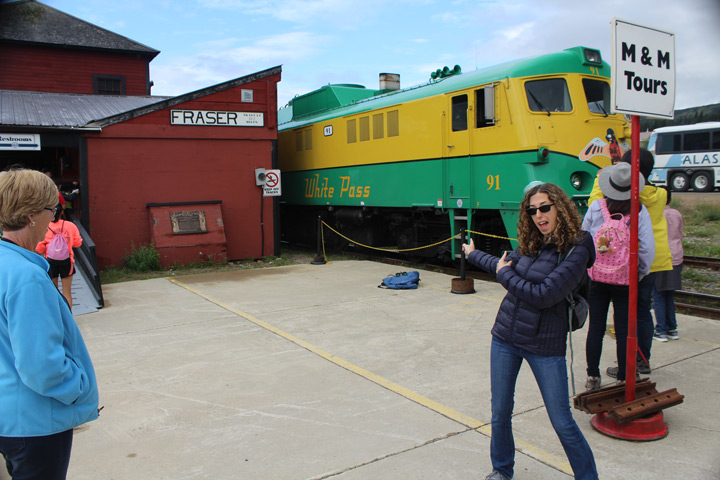
The end of (our) line ... the train depot in Fraser.

Rugged landscape along the White Pass & Yukon Railroad.
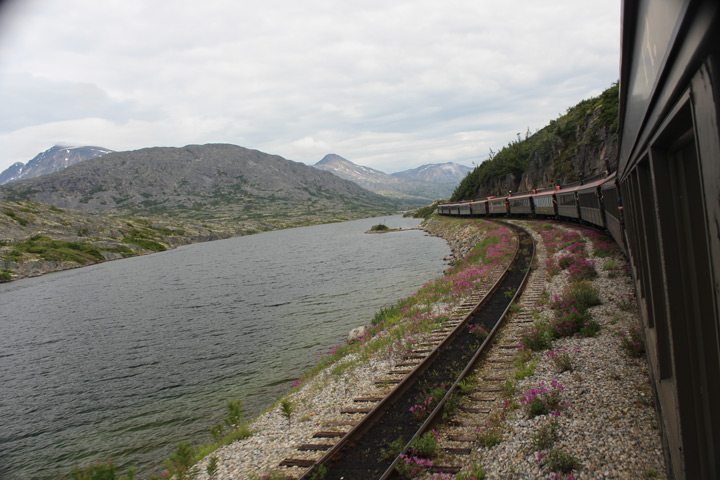
Long train running. White Pass & Yukon Railroad.
On paper, this was a horrible idea. Everything that makes Southeast Alaska fun to look at also makes it nigh impossible to build a practical railroad. The canyons are steep and twisty, so you need a distressing number of bridges, tunnels and road cuts to make a path that is flat enough, wide enough and straight enough. But if you have enough financial backing (and only mild respect for human life) you can accomplish great things. The White Pass & Yukon route was finished in a little over a year, connecting coastal Skagway to Whitehorse, about 110 miles away in the Yukon Territory. A hike that used to take weeks and carried a high chance of death could now be replaced with a train ride of a few hours. And it was all completed just in time for the end of the gold rush.
Ha!
When railroad builders were hanging off cliffs and blowing off fingers for 15 straight months, they probably had no idea that they were actually building the ultimate cruise ship attraction: A sedentary activity with historic value and amazing views. The White Pass & Yukon Railroad has survived to the modern day by becoming a "scenic" railroad, and its reputation is excellent. My dad said he loved it, and on his endorsement it was the first excursion we booked when planning our vacation!
Of course, we were there one day after an amazing visit to a glacier, which my dad had warned was boring. So when we stepped off the Millennium around 8 a.m., we weren't sure what to expect.
Our tour started with a bus ride. A guy named Mike picked up me, Allyson and 20 of our closest friends. He was going to drive us along the Klondike Highway, a modern road that roughly follows the path of the railroad on the other side of the Skagway River. A few miles past the Canadian border, he would drop us off at Canadian customs, where we would board the train and ride all the way back to Skagway.
Mike was good and funny guide, and his stories about life in modern Skagway were highly entertaining. He made ends meet by doing construction in the offseason, and he explained how Skagwagians (Skagwayers? Skagwayites?) have to do a lot of their grocery shopping in the thriving metropolis of Whitehorse, population 23,000. That's 100 miles away in Canada -- so if a friend offers to pick something up, you say yes. Mike was an expert photographer, and he knew all the best pull-offs for getting scenic shots.
Of course, so did every other bus driver. There had to be at least four other buses on the same schedule as us. When we crossed into Canada and stopped to see the "welcome to Alaska" sign, there was a large mob of people trying to get pics that included them, the sign, and the illusion that there weren't 150 other people just out of frame.
Mike also pointed out all kinds of natural stuff. The Klondike Highway climbs steadily, and before long there's a distinct change in vegetation. The huge coastal trees disappear as the landscape switches to tundra, where yellow moss and stubby little trees take over.
Mike's heroic efforts aside, we were mostly looking at scenery from inside a bus. So this was not the highlight of our vacation. Allyson has a hard time staying awake in any ground vehicle that she isn't driving. I've seen her go into a coma five minutes into a morning car ride, even coming off a full night's rest. She's also somehow not a "scenery" person, having concluded that bus windows make most mountains and rivers look the same. We've tried to have a lively debate about this, but Allyson also has a hard time staying awake when I'm explaining to her that she's wrong.
But things soon kicked into high gear as we WENT THROUGH CUSTOMS! And BOARDED THE TRAIN! And SAT ON THE STATIONARY TRAIN FOR AN HOUR WAITING TO DEPART!
The ride back allowed us to see the same scenery, but with a much cooler perspective. We were on the other side of the river, crossing over impressive trestles and seeing the engineering of the railroad up close. We were also allowed to stand on the small exterior platforms at the front and rear of our train car. There were a few problems with what I hereby dub "screen queens" -- people who refuse to look at anything without the assistance of a digital device. We saw a man record maybe 40 minutes of passing blurry scenery, and he did this by standing perpetually in the view of anyone else trying to look off the side of the platform. We kept hoping that he'd lose his phone over the side, but Raven was not with us that day.
The railroad was pleasant enough, for a means of conveyance soaked in misery and death. You don't have to be an engineer to appreciate the audacity and beauty of what was accomplished with late-19th-century technology. But Alaska had already spoiled us, so this excursion wasn’t quite thrilling. There was a little too much waiting, a little too much sitting and not nearly enough helicopter landings on top of mountains.

Skagway, a federally preserved gold rush town.
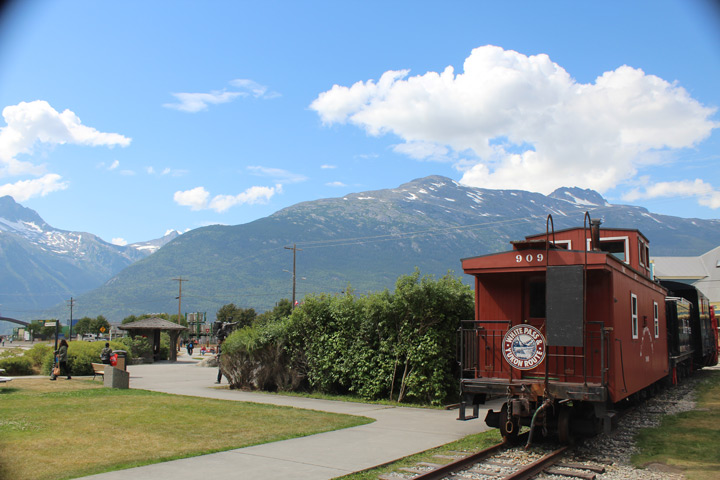
Tourism keeps the lights on in Skagway ...
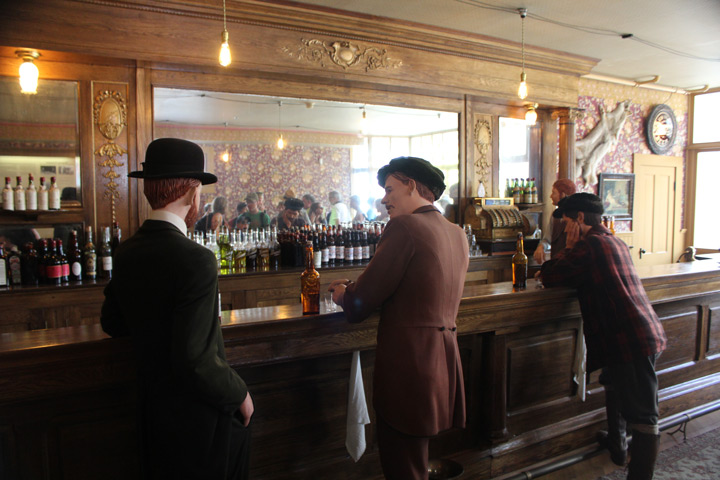
The National Park Service keeps some of the gold-rush buildings in peak condition. Here's a tavern.
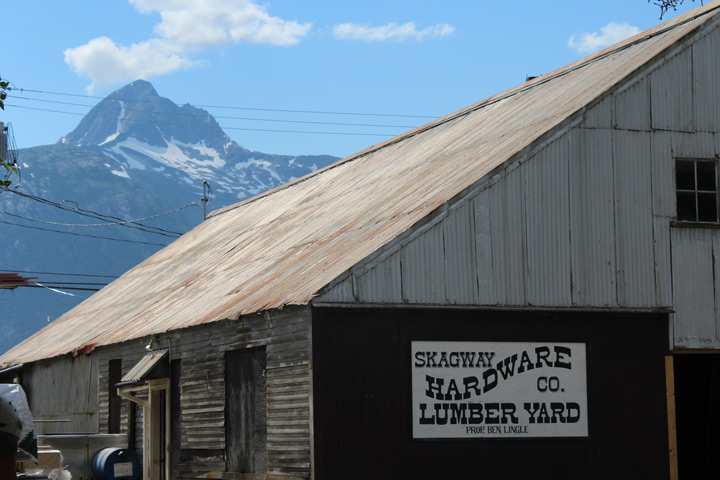
Pretty scenic for a warehouse, right?

Inside the Moore home. They were some of the wealthiest people in Skagway.
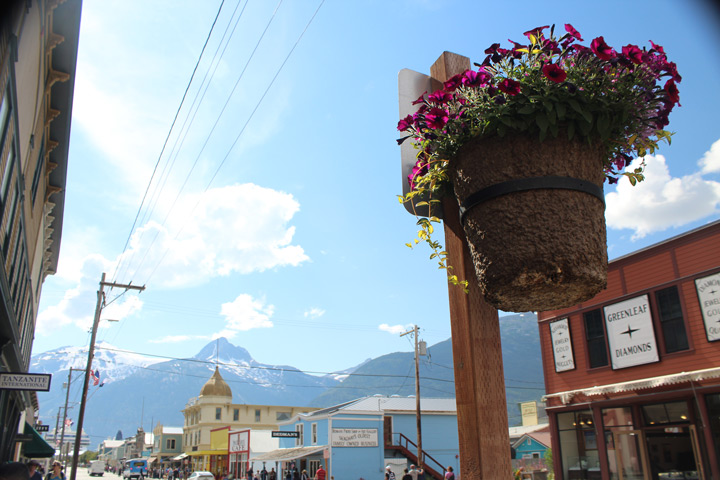
Main streets don't get much better than this. Skagway.
But we still had Skagway to enjoy! Thanks to the good people of the National Park Service, the main drag in Skagway looks something like the Skagway of the 1890s, with substantially less venereal disease. America's fascination with the gold rush led to the creation of the Klondike Gold Rush National Historical Park. The government owns and operates a handful of historic buildings, and easements on the rest of the historic district help private owners keep their structures cosmetically compatible with the historic buildings. The sidewalks are all boardwalks -- just like the 1890s, when the streets would have been festering pits of diseased mud. At the height of the gold rush, Skagway would have been a cramped, smelly, testosterone-soaked den of iniquity. Now it's kind of cute, with people in ranger uniforms whose job is to tell you about all the iniquity.
This is my vacation wheelhouse. I could spend all day in a historic home, district or park. I would gladly grill a park ranger until they have unquestionably earned every penny of their annual taxpayer-provided salary. Allyson is less enthusiastic about history and the Park Service, but she'll go along if you keep her fed. After getting off the train, we had lunch at a place called Olivia's. Then we found the Park Service headquarters. Within minutes, we determined that there was only one option for our afternoon: A 2 p.m. walking tour called "Mining the Miners."
The gold rush attracted people hoping to make a lot of money in a very short time. Most of those people failed miserably, exhausting their finances as they discovered that they had badly misjudged what it took to succeed. The only people who reliably made money were those exploiting the idiots: tavern owners, con men, prostitutes and so forth.
Our excellent lady ranger walked our group to a gambling den, a restored tavern, the location of an old hotel, and the home where William Moore's son lived with the Tlingit woman that he married to cement his status as a big cheese of Skagway.
The most memorable stories involved Soapy Smith, who fleeced miners mercilessly; one of his "best" scams involved taking payment to send telegrams when he had no such equipment. The even better scam was when he fabricated answers to the telegrams he had never sent. Amazingly enough, he was shot in the street. The saddest stories involved Minnie Moore, the daughter-in-law of William. She struggled with her mental health, which probably wasn't improved by massive racism against the Tlingit.
My M.O. in these situations is to stick close to the guide and ask a ton of questions, to the point where most of the tour group is resentful. Park rangers are the best, because they HAVE to do extensive reading -- if they don't answer your questions, it’s a violation of federal law. (I assume.) I had a perfect record to protect: No group tour with me as member has ever finished in the usual amount of time. We had a cruise ship to board, so there had to be limits this time out, but I did manage to slow things down a great deal. Allyson is now at the point where she finds this amusing, probably due to Stockholm syndrome. But she also enjoyed the stories of Skagway, as they involved plenty of criminal enterprise and filthy people doing morally questionable things. I married an unusual woman.
This was by far the most history-oriented part of vacation. So despite the mild letdown of the scenic railroad, I deem the day a roaring success, because knowing history is what makes me feel superior to other people.
Back on the boat, we closed out the day by watching a Russian gymnast team in the theater. Yulia and Alan Reva put on a pretty amazing show, especially when you consider that they're doing a lot of high-stakes balancing and flipping in a venue that is continually rolling from side to side. I don't know if they can do that show on a ship anywhere other than the glassy Inside Passage, but you gotta give credit where credit is due. There's also a lot of great conversation that can come out of watching Yulia and Alan. Yulia is flexible enough that any man watching will inevitably make a comment that should offend a reasonable woman. Alan (who worked with the Chippendales) seems to have a negative body-fat percentage and abs that could stop a cannonball at close range. You will be absolutely convinced that your wife is fantasizing about him in the months that follow.
Fortunately for me, I know my wife loves me for my extensive knowledge of history. It keeps me secure. Cough, cough.
Day Eight: Hubbard Glacier
At some point on your Alaskan cruise it will be mentioned that cruise ships first visited Alaska more than 100 years ago. The "last frontier" was so enticing -- and the Inside Passage so refreshingly calm -- that even 19th-century Americans set sail, despite a lack of cruise ship comedians or Russian gymnasts. A highlight of those early cruises, aside from meeting the heavily corseted woman of your dreams, was an up-close encounter with a glacier.
Cruise ships and their passengers are a bit different in the 21st century, but glaciers still have their appeal. Our last day on the Millennium, there would be no port. But we were going to check out the Hubbard Glacier.
To get the best view of a glacier from a cruise ship, you need clear skies, calm seas and -- this is a big one -- relatively few icebergs. For some reason, no cruise company wants to have the next Titanic on its hands. If anything seems like a potential threat to the boat, they'll stop short and tell their passengers to blame God.
In terms of what we could control as passengers, the important thing was to get up early. We were told that the Millennium would be in the vicinity of the glacier between 6 a.m. and 10 a.m., sail as close as possible, then reverse course to the open sea. The ship is big, but only a few viewing areas on the upper decks would be ideal -- and it stood to reason that they'd be mob scenes. Most people are friendly and relaxed on a cruise, but when it's time to hold up your iPad to record a 35-minute video of slow-moving ice floes, it's Thunderdome.

Approaching Hubbard Glacier on the Millennium.
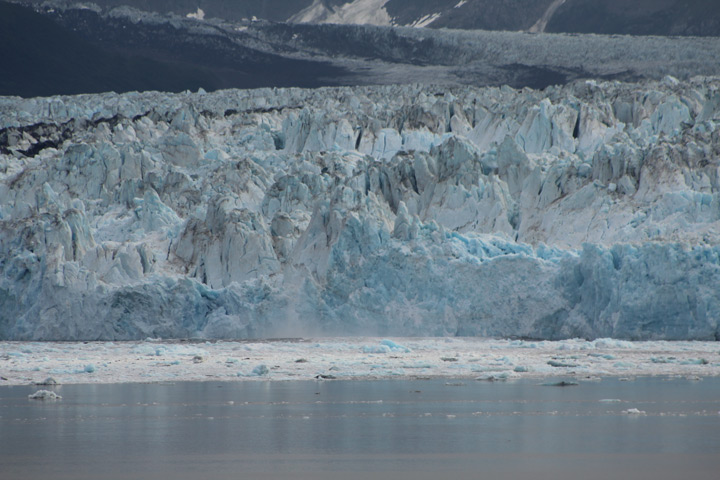
A view of the Hubbard Glacier, from the deck of the Millennium.
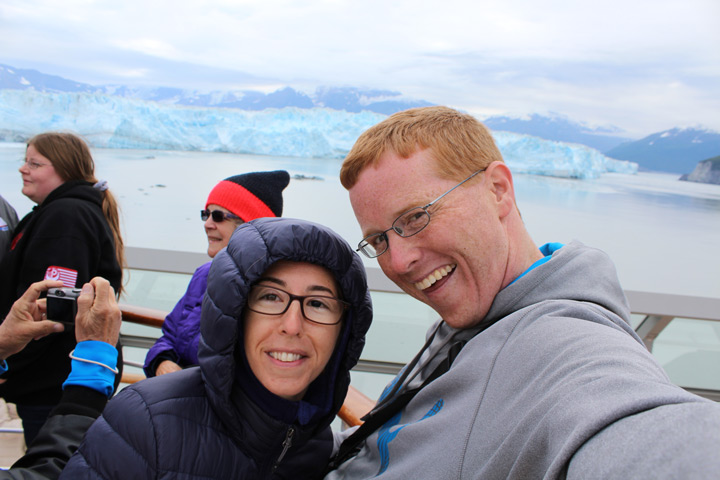
Ice, ice, baby. Too cold. Too cold.

Oddly, no one celebrated the glacier-viewing by taking a swim.
Marriages are much stronger if both partners understand their roles. In my marriage, I am the taller person who can see over things and box out aggressive middle-aged Midwesterners. It's really all that I'm bringing to the table, so it was my duty to get to the deck first. Early in the morning, I put on a sweatshirt, grabbed our camera and headed to 12 forward. You can't get much higher on the ship, and even though that deck doesn’t extend to the edge of the boat, it is higher than the plexiglass shield surrounding 11 forward. Of course, at that height there was no shelter from the wind. And there was a lot of wind, probably thanks to the huge block of ice we were approaching.
There's not much to share outside of the pictures. The crowd filled in, and the glacier slowly grew on the horizon. We were told by the ship's naturalist that the conditions were unusually good, and with the aid of a local pilot they steered the ship within a mile or so of the glacier's face. That meant picking our way through icebergs. Some of them were a stunning glacial blue. Some of them hosted groups of seals.
The real show begins when you're up close: Every few minutes, there's a sound akin to thunder, as pieces of the glacier "calve" and drop into the harbor. Like the Herbert Glacier, the real challenge was getting a sense of scale. We were on a 13-story ship, and the face of the glacier was towering over us. But from a mile away, it was still easy to underestimate the sheer size of it all.
As the ship turned away, the scenic cruising was over. The Inside Passage was behind us, and we took to the open sea to make the final dash to Seward. All that was left of our cruise was a few more hours to explore the ship, or to endure sales pitches for souvenir photographs and that sort of thing.
Looking over these notes, there has been little mention of the time on the Millennium. A few months removed, those parts of the vacation don't stand out. It's a fine ship, and we spent hours on the balcony, at the gym, or in the lounges. Each night, we enjoyed dinner at Blu, and before each dinner we had a drink at the nearby wine bar. We had pleasant chats with pleasant people about a lot of things. Most of those people, we'll never see again.
If there were any standouts, it was Yuval and Brenda, our new friends from Montreal. Yuval is a computer guy, and Brenda is a yoga instructor. Each of them had been married, and now they were dating. Brenda shared Allyson's love of stories involving murderous women, and I was more than capable of chatting with Yuval while the ladies discussed ways to kill us. We spent our last night on the ship having dinner with them, and I would like it if our paths should cross again.
It was a good cruise. We saw a great many things in a very short time, and we enjoyed each other's company the whole way. There were no bears. But there was plenty of hope for the week to come.
